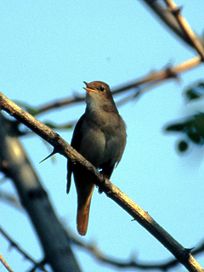Nightingale
| Nightingale | ||||||||||||||
|---|---|---|---|---|---|---|---|---|---|---|---|---|---|---|
 |
||||||||||||||
| Conservation status | ||||||||||||||
| Scientific classification | ||||||||||||||
|
||||||||||||||
| Binomial name | ||||||||||||||
| Luscinia megarhynchos (Brehm, 1831) |
The Nightingale (Luscinia megarhynchos), also known as Rufous and Common Nightingale, is a small passerine bird that was formerly classed as a member of the thrush family Turdidae, but is now more generally considered to be an Old World flycatcher, Muscicapidae. It belongs to a group of more terrestrial species, often called chats.
It is a migratory insectivorous species breeding in forest and scrub in Europe and south-west Asia. The distribution is more southerly than the very closely related Thrush Nightingale Luscinia luscinia. It nests on the ground within or next to dense bushes. It winters in southern Africa. At least in the Rhineland (Germany), the breeding habitat of nightingales agrees with a number of geographical parameters.[2]
- less than 200 m (600 ft) above mean sea level
- mean air temperature during the growing season above 14°C
- more than 20 days/year on which temperatures exceed 25°C
- annual precipitation less than 750mm
- aridity index lower than 0.35
- no closed canopy.
The Nightingale is slightly larger than the European Robin, at 15-16.5 cm length. It is plain brown above except for the reddish tail. It is buff to white below. Sexes are similar.
Nightingales are named so because they frequently sing at night as well as during the day. The name has been used for well over 1,000 years, being highly recognizable even in its Anglo-Saxon form - 'nihtingale'. It means 'night songstress'. Early writers assumed the female sang; but in fact, we have learned it is the male. The male nightingale is known for his singing, to the extent that human singers are sometimes admiringly referred to as nightingales; the song is loud, with an impressive range of whistles, trills and gurgles. Its song is particularly noticeable at night because few other birds are singing. This is why its name (in several languages) includes "night". Only unpaired males sing regularly at night, and nocturnal song is likely to serve attracting a mate. Singing at dawn, during the hour before sunrise, is assumed to be important in defending the bird's territory. Nightingales sing even more loudly in urban or near-urban environments, in order to overcome the background noise. The most characteristic feature of the song is a loud whistling crescendo, absent from the song of Thrush Nightingale. It has a frog-like alarm call.
The eastern subspecies L. m. hafizi and L. m. africana have paler upperparts and a stronger face-pattern, including a pale supercilium.
Culture
- John Keats's "Ode to a Nightingale" has attracted high praise, the upper limit of which may be "one of our shorter English lyrics that still seems to me... the nearest to perfection, the one I would surrender last of all"[3] and "one of the final masterpieces of human work in all time and for all ages".[4]
- The love of the nightingale for the rose is also widely used, often metaphorically, in Turkish literature (especially in poems of the Ottoman period) as well as in Persian literature.[5]
- A Provençal folk song, "The Nightingale Which Flies", inspired Tchaikovsky when composing his Humoresque opus 10-2.
References
- ↑ BirdLife International (2004). Luscinia megarhynchos. 2006 IUCN Red List of Threatened Species. IUCN 2006. Retrieved on 12 May 2006. Database entry includes justification for why this species is of least concern
- ↑ (German) Wink, Michael (1973): " Die Verbreitung der Nachtigall (Luscinia megarhynchos) im Rheinland". Charadrius 9(2/3): 65-80. (PDF)
- ↑ Stedman, Edmund C. (1884), "Keats", The Century XXVII: 600, http://books.google.com/books?id=XLWqByOcRjwC&pg=PA600
- ↑ Swinburne, Algernon Charles (1886), "Keats", Miscellanies, New York: Worthington Company, pp. 221, http://books.google.com/books?id=UHsRAAAAYAAJ&pg=PA211, retrieved on 2008-10-08. Reprinted from the Encyclopædia Britannica.
- ↑ "The Rose and nightingale in Persian literature".
External links
- Internet Bird Collection: Nightingale videos. Retrieved 2008-NOV-11.
- The Freesound Project: Uncompressed high-quality Nightingale sound file (requires free account to download). Retrieved 2006-DEC-09.
- The Freesound Project: High-quality Nightingale sound file (requires free account to download). Retrieved 2006-DEC-09.
- Royal Society for the Protection of Birds (British)- Nightingale [1]. Retrieved 2007-JUN-11.
- Rose and nightingale in Persian art [2]
- Nightingale song and behavioural ecology [3]
- Ageing and sexing (PDF) by Javier Blasco-Zumeta